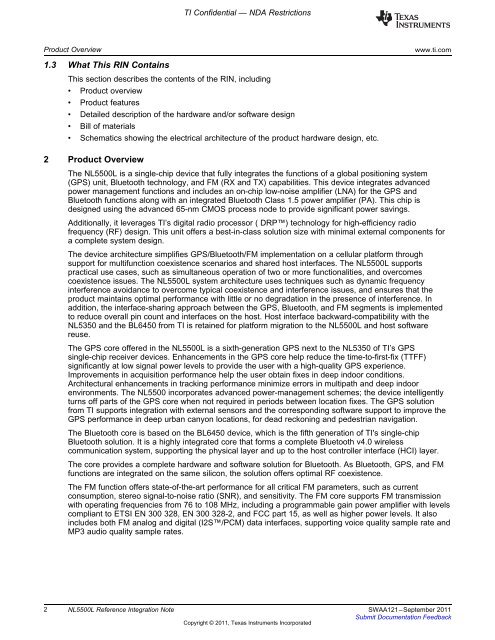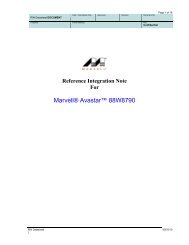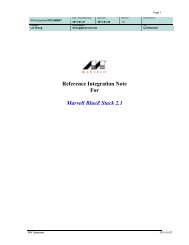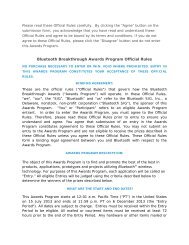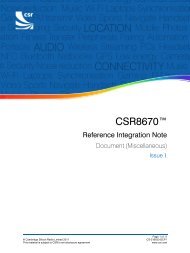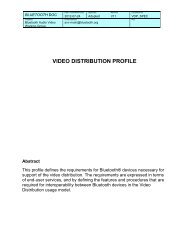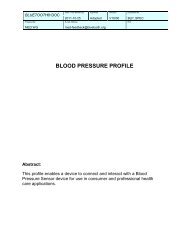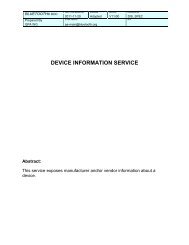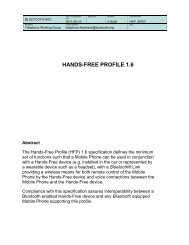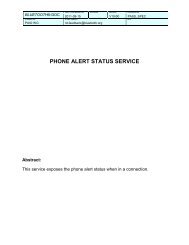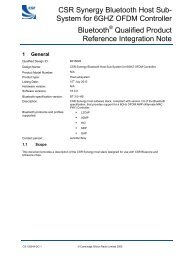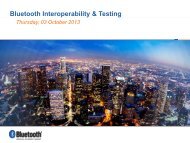NL5500L Reference Integration Note - Bluetooth
NL5500L Reference Integration Note - Bluetooth
NL5500L Reference Integration Note - Bluetooth
Create successful ePaper yourself
Turn your PDF publications into a flip-book with our unique Google optimized e-Paper software.
TI Confidential — NDA RestrictionsProduct Overviewwww.ti.com1.3 What This RIN ContainsThis section describes the contents of the RIN, including• Product overview• Product features• Detailed description of the hardware and/or software design• Bill of materials• Schematics showing the electrical architecture of the product hardware design, etc.2 Product OverviewThe <strong>NL5500L</strong> is a single-chip device that fully integrates the functions of a global positioning system(GPS) unit, <strong>Bluetooth</strong> technology, and FM (RX and TX) capabilities. This device integrates advancedpower management functions and includes an on-chip low-noise amplifier (LNA) for the GPS and<strong>Bluetooth</strong> functions along with an integrated <strong>Bluetooth</strong> Class 1.5 power amplifier (PA). This chip isdesigned using the advanced 65-nm CMOS process node to provide significant power savings.Additionally, it leverages TI’s digital radio processor ( DRP) technology for high-efficiency radiofrequency (RF) design. This unit offers a best-in-class solution size with minimal external components fora complete system design.The device architecture simplifies GPS/<strong>Bluetooth</strong>/FM implementation on a cellular platform throughsupport for multifunction coexistence scenarios and shared host interfaces. The <strong>NL5500L</strong> supportspractical use cases, such as simultaneous operation of two or more functionalities, and overcomescoexistence issues. The <strong>NL5500L</strong> system architecture uses techniques such as dynamic frequencyinterference avoidance to overcome typical coexistence and interference issues, and ensures that theproduct maintains optimal performance with little or no degradation in the presence of interference. Inaddition, the interface-sharing approach between the GPS, <strong>Bluetooth</strong>, and FM segments is implementedto reduce overall pin count and interfaces on the host. Host interface backward-compatibility with theNL5350 and the BL6450 from TI is retained for platform migration to the <strong>NL5500L</strong> and host softwarereuse.The GPS core offered in the <strong>NL5500L</strong> is a sixth-generation GPS next to the NL5350 of TI’s GPSsingle-chip receiver devices. Enhancements in the GPS core help reduce the time-to-first-fix (TTFF)significantly at low signal power levels to provide the user with a high-quality GPS experience.Improvements in acquisition performance help the user obtain fixes in deep indoor conditions.Architectural enhancements in tracking performance minimize errors in multipath and deep indoorenvironments. The NL5500 incorporates advanced power-management schemes; the device intelligentlyturns off parts of the GPS core when not required in periods between location fixes. The GPS solutionfrom TI supports integration with external sensors and the corresponding software support to improve theGPS performance in deep urban canyon locations, for dead reckoning and pedestrian navigation.The <strong>Bluetooth</strong> core is based on the BL6450 device, which is the fifth generation of TI's single-chip<strong>Bluetooth</strong> solution. It is a highly integrated core that forms a complete <strong>Bluetooth</strong> v4.0 wirelesscommunication system, supporting the physical layer and up to the host controller interface (HCI) layer.The core provides a complete hardware and software solution for <strong>Bluetooth</strong>. As <strong>Bluetooth</strong>, GPS, and FMfunctions are integrated on the same silicon, the solution offers optimal RF coexistence.The FM function offers state-of-the-art performance for all critical FM parameters, such as currentconsumption, stereo signal-to-noise ratio (SNR), and sensitivity. The FM core supports FM transmissionwith operating frequencies from 76 to 108 MHz, including a programmable gain power amplifier with levelscompliant to ETSI EN 300 328, EN 300 328-2, and FCC part 15, as well as higher power levels. It alsoincludes both FM analog and digital (I2S/PCM) data interfaces, supporting voice quality sample rate andMP3 audio quality sample rates.2 <strong>NL5500L</strong> <strong>Reference</strong> <strong>Integration</strong> <strong>Note</strong> SWAA121–September 2011Submit Documentation FeedbackCopyright © 2011, Texas Instruments Incorporated


